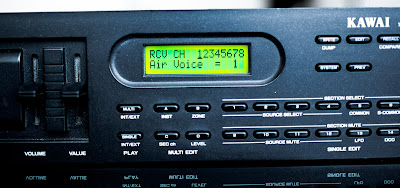SOLVED - KAWAI K4 / K4r 16Bit Sound Module Problem Setup After Battery Replacement
HAVING PROBLEMS GETTING ANY SOUND FROM THE KAWAI K4 / K4r SOUND MODULE AFTER REPLACING ITS INTERNAL BATTERY?
Seeing this message on the screen...? (* KAWAI K4r * SYNTHESIZER) It usually appears at start up then disappears, but if it continues to show and no matter what you do you get no response, then you've come to the right place... Read on...
When producing Electronic Music, DAW software has allowed us to use automation and save that data within its software. This what we call 'System Exclusive' information.
In simple terms, it allows you to record Music/MIDI data and save it for future use, never losing the creative ideas you put down for future use. The last thing you want is to create an amazing, automated piece and not save it, only to have to try and recreate it again, "That moment has gone!"
In music, DAW today you would probably be using USB devices that connect straight to your computer. Some new electronic devices still come with a MIDI In/Out (and if you're lucky, sometimes a Thru). This allows you to use older music electronic devices...
MIDI = Musical Instrument Digital Interface.
DAW = Digital Audio Workstation
* KAWAI K4r * SYNTHESIZER
... The K4 (keyboard synthesizer) / K4r (rack mount version) is just that. It does not have a USB interface, it uses MIDI
In order for the K4/K4r to interact and talk with your music software on your computer, you will need a MIDI to USB interface.
Back in the day musical instruments and sound modules used MIDI, it was a way of talking and communicating and exchanging data to your computer music sequencing software by 'Receive and Send.'
REPLACED THE INTERNAL BATTERY, SWITCHED ON AND NOW YOU HAVE NO SOUND AND CAN'T ACCESS ANY INFORMATION NO MATTER WHICH BUTTON YOU PRESS!
This means the Internal/System Exclusive information has been lost, but don't panic! If you performed a 'System Exclusive MIDI Dump' from the K4 / K4r to your DAW/Music Editing software then you're safe.
What if you don't have your data backed up?
Kawai still do a legacy page on all their products, scroll down until you reach your desired Instrument. In our case we want the K-4 - Here you will see three links:
NOTE: Clicking on each of the links will automatically download the files.
1: K-4 zip - SYSEX versions of all factory banks. (Includes read me instructions and a SYSEX utility for PC).
2: K-4 Multis.rtf Explanation of how to create a K4 multi patch for use as a sequencing template. (I have performed this process on Multi/I ID-9).
3: K-4 SMFzip SMF versions of all k4 factory sound banks (Includes read me instructions).
NOTE: MIDI OUT from USB Interface connects to MIDI IN of K4 / K4r.
Follow Instructions as provided in the above link section 1, advance users can open SYSEXC Midi file in their music software, set K4 to receive MIDI data (make sure Protect is set to OFF) press play on your music software and the SYSEX (system exclusive) data should start transmitting to the K4 / K4r and that's it (It happens so quickly)! The screen will now be showing an instrument name on the screen. Remember to turn Protect back to ON.
Use the Value slider on the left to change the ON parameter to OFF or the -NO or +YES. on the right.
Below is a chart I put together for the Patch List Sound Banks:
Link download here: K4 / K4r Factory Sounds
HOW TO SETUP AND CREATE A MULTI PATCH OR SEQUENCE USING MY K-4 SYNYTH.
(Midi Channel 10 = Drums)
Thanks for reading, I hope you found this post helpful.
Edmahoo.



















Comments
Post a Comment